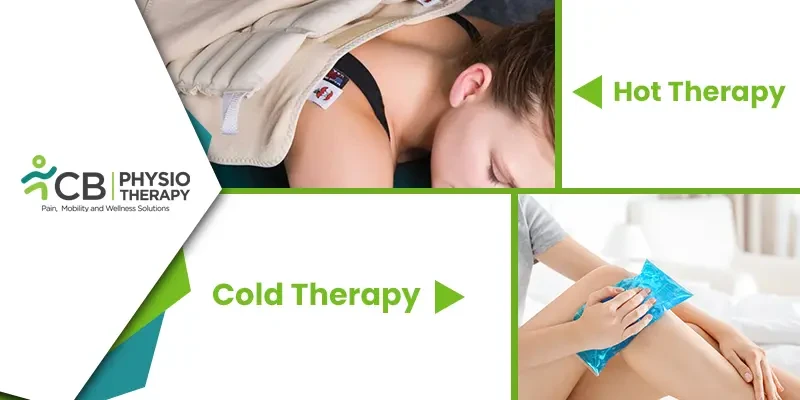Are you confused about when to use Cold therapy and Heat therapy after an injury? To find an answer to your question you need to go through this blog. Cold and heat therapy both can reduce pain. Cryotherapy (cold therapy) and thermotherapy (heat therapy) are useful adjuncts for the treatment of musculoskeletal injuries and soft tissue injuries. These therapies decrease pain in joints and muscles as well as soft tissues and have opposite effects on tissue metabolism, blood flow, and connective tissue extensibility.
Thermotherapy or Heat therapy
Thermotherapy consists of applying heat to the targeted area to induce a desired biological response. The majority of thermotherapies are designed to deliver thermal therapy to the tissue volume with minimal impact on intervening or surrounding tissues.
Superficial heat can be applied to the tissues by using hot packs, hot towels, heat wraps, wax baths, steam baths, saunas, and steam baths/rooms. Heat can be induced in the deeper tissues by electrotherapy modalities like ultrasound therapy, infrared radiation, shockwave, etc.
Exercise in warm water is a popular and effective treatment for pain relief for patients with painful musculoskeletal or neurologic conditions. The warmth of the water can block the nociception by acting on thermal receptors and mechanoreceptors, thus influencing spinal segmental mechanisms. It gives positive effects on cutaneous barrier homeostasis and anti-inflammatory activity. It also enhances blood flow and muscle relaxation. The hydrostatic effect may also relieve pain by reducing edema and dampening sympathetic nervous system activity.
Effects of Thermotherapy (Heat therapy):
By increasing the temperature of the skin or soft tissue:
- Vasodilation occurs causing an increase in the blood flow.
- Metabolic rate increases,
- Tissue extensibility also increases.
- Oxygen uptake increases.
- Tissue healing accelerates.
- Increases the efficacy of destructive enzymes.
- Increases joint temperature.
- Causes muscle relaxation.
- Decreases joint stiffness.
- Increases flexibility.
The use of thermotherapy can benefit individuals suffering from:
- Back pain, shoulder pain, knee pain, etc.
- Osteoarthritis,
- Rheumatoid arthritis,
- Chronic joint pain,
- Chronic muscle pain,
- Muscle spasms,
- Joint contracture, etc.
Cryotherapy or Cold Therapy:
Cold therapy can be applied by using ice packs, cooling gel packs, ice baths, cold air, sprays, etc. Cold therapy is an effective treatment for soft tissue injuries. It reduces swelling and improves the range of motion. The application of ice may be useful for a variety of conditions.
Effects of Cryotherapy (Cold therapy):By decreasing the temperature of the skin or soft tissue:
- Vasoconstriction occurs causing a decrease in the blood flow.
- Prevents hypoxic damage i.e hunting reflex.
- The tissue metabolism will decrease just like the neuronal excitability.
- Inflammation decreases.
- Tissue extensibility decreases.
- The conduction rate decreases.
- The activity of the cartilage-degrading enzyme decreases.
- Collagenase, elastase, hyaluronidase, and protease, activity is inhibited.
- Numbs the pain, and decreases swelling.
- Blocks nerve impulses to the joints.
Conditions that can benefit from Cryotherapy (Cold therapy):
There are various conditions that can benefit from cold therapy, these include:
- Tendonitis (jumper's knee, tennis elbow).
- Recurrent ligament/joint inflammation (arthritis flare-ups).
- Shin splints.
- Plantar fasciitis.
- Overuse injuries.
- Strained or pulled muscles.
- Sprains (shoulder, wrist, ankle).
- Impact injuries to soft tissues like bruised hips, jammed fingers, facial traumas, etc.
Mechanism of action of Heat therapy and Cold therapy
Skin blood flow is controlled by two branches of the sympathetic nervous system, a cholinergic active vasodilator system, and a noradrenergic vasoconstrictor system. These dual sympathetic neural control mechanisms affect the major aspects of thermoregulatory responses on most of the human body's surface.
During periods of hypothermia, falling skin temperatures lead to an increase in sympathetic active vasoconstrictor nerve activity to reduce skin blood flow and conserve body heat.
During periods of heat stress, increasing skin temperatures lead to increase in sympathetic active vasodilator nerve activity to increase skin blood flow.
Contraindications for Heat therapy and Cold therapy:
There are certain conditions in which heat therapy should not be used. These include:
- Acute traumas/injuries,
- Allergies to heat,
- Numbness of area being heated,
- Open wound,
- Heart conditions like coronary artery disease, heart failure, etc,
- Diabetes,
- Dermatitis,
- Vascular diseases,
- Multiple sclerosis,
- Deep vein thrombosis, etc.
Certain conditions in which cold therapy should not be given include:
- Cold allergy,
- Sensory loss of superficial nerves opens wounds.
- Hypersensitivity to cold,
- Hypertension.
- Coronary artery disease,
- Asthma,

